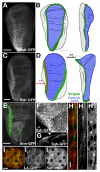Dual role of myosin II during Drosophila imaginal disc metamorphosis
- PMID: 23612302
- PMCID: PMC3736102
- DOI: 10.1038/ncomms2763
Dual role of myosin II during Drosophila imaginal disc metamorphosis
Abstract
The motor protein non-muscle myosin II is a major driver of the movements that sculpt three-dimensional organs from two-dimensional epithelia. The machinery of morphogenesis is well established but the logic of its control remains unclear in complex organs. Here we use live imaging and ex vivo culture to report a dual role of myosin II in regulating the development of the Drosophila wing. First, myosin II drives the contraction of a ring of cells that surround the squamous peripodial epithelium, providing the force to fold the whole disc through about 90°. Second, myosin II is needed to allow the squamous cells to expand and then retract at the end of eversion. The combination of genetics and live imaging allows us to describe and understand the tissue dynamics, and the logic of force generation needed to transform a relatively simple imaginal disc into a more complex and three-dimensional adult wing.
Figures






Similar articles
-
Exploiting Drosophila melanogaster Wing Imaginal Disc Eversion to Screen for New EMT Effectors.Methods Mol Biol. 2021;2179:115-134. doi: 10.1007/978-1-0716-0779-4_11. Methods Mol Biol. 2021. PMID: 32939717
-
Towards long term cultivation of Drosophila wing imaginal discs in vitro.PLoS One. 2014 Sep 9;9(9):e107333. doi: 10.1371/journal.pone.0107333. eCollection 2014. PLoS One. 2014. PMID: 25203426 Free PMC article.
-
Forces shaping the Drosophila wing.Mech Dev. 2017 Apr;144(Pt A):23-32. doi: 10.1016/j.mod.2016.10.003. Epub 2016 Oct 23. Mech Dev. 2017. PMID: 27784612 Review.
-
Loss of non-muscle myosin II Zipper leads to apoptosis-induced compensatory proliferation in Drosophila.Biochim Biophys Acta Mol Cell Res. 2025 Jun;1872(5):119939. doi: 10.1016/j.bbamcr.2025.119939. Epub 2025 Mar 27. Biochim Biophys Acta Mol Cell Res. 2025. PMID: 40157509
-
Cultivation and Live Imaging of Drosophila Imaginal Discs.Methods Mol Biol. 2016;1478:203-213. doi: 10.1007/978-1-4939-6371-3_11. Methods Mol Biol. 2016. PMID: 27730583 Review.
Cited by
-
Maintenance of Cell Fate by the Polycomb Group Gene Sex Combs Extra Enables a Partial Epithelial Mesenchymal Transition in Drosophila.G3 (Bethesda). 2020 Dec 3;10(12):4459-4471. doi: 10.1534/g3.120.401785. G3 (Bethesda). 2020. PMID: 33051260 Free PMC article.
-
Epithelial organ shape is generated by patterned actomyosin contractility and maintained by the extracellular matrix.PLoS Comput Biol. 2020 Aug 20;16(8):e1008105. doi: 10.1371/journal.pcbi.1008105. eCollection 2020 Aug. PLoS Comput Biol. 2020. PMID: 32817654 Free PMC article.
-
The transmembrane protein Syndecan is required for stem cell survival and maintenance of their nuclear properties.PLoS Genet. 2025 Feb 6;21(2):e1011586. doi: 10.1371/journal.pgen.1011586. eCollection 2025 Feb. PLoS Genet. 2025. PMID: 39913561 Free PMC article.
-
Apical and Basal Matrix Remodeling Control Epithelial Morphogenesis.Dev Cell. 2018 Jul 2;46(1):23-39.e5. doi: 10.1016/j.devcel.2018.06.006. Dev Cell. 2018. PMID: 29974861 Free PMC article.
-
Receptor-interacting Ser/Thr kinase 1 (RIPK1) and myosin IIA-dependent ceramidosomes form membrane pores that mediate blebbing and necroptosis.J Biol Chem. 2019 Jan 11;294(2):502-519. doi: 10.1074/jbc.RA118.005865. Epub 2018 Nov 12. J Biol Chem. 2019. PMID: 30420430 Free PMC article.
References
-
- Escudero LM, Bischoff M, Freeman M. Myosin II regulates complex cellular arrangement and epithelial architecture in Drosophila. Dev Cell. 2007;13:717–729. - PubMed
-
- Bertet C, Sulak L, Lecuit T. Myosin-dependent junction remodelling controls planar cell intercalation and axis elongation. Nature. 2004;429:667–671. - PubMed
-
- Young PE, Richman AM, Ketchum AS, Kiehart DP. Morphogenesis in Drosophila requires nonmuscle myosin heavy chain function. Genes Dev. 1993;7:29–41. - PubMed
-
- Karess RE, et al. The regulatory light chain of nonmuscle myosin is encoded by spaghetti-squash, a gene required for cytokinesis in Drosophila. Cell. 1991;65:1177–1189. - PubMed
Publication types
MeSH terms
Substances
Grants and funding
LinkOut - more resources
Full Text Sources
Other Literature Sources
Molecular Biology Databases

